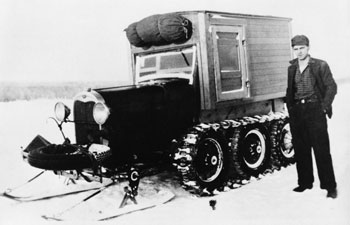Preventing an epidemic
Confirming a case of diptheria
In late 1928, Dr. Hamman confirmed a case of diphtheria in the remote settlement of Little Red River about 80 km northeast of Fort Vermilion. He had been practicing there since 1924, when he accepted a $2,700 per year contract from Indian Affairs and the Government of Alberta to serve 900 Treaty Indians and Fort Vermilion residents on the lower Peace River. His practice extended 350 km upstream to Peace River and 320 km downstream to Hay River.
Although Fort Vermilion had a 10-bed hospital, there was no pharmacy. Dr. Hamman had to buy his own medicine and recover what he could from his patients.
In December 1928, he received a letter from Little Red River, asking him to see a patient. Because the symptoms suggested diphtheria — an often fatal upper respiratory tract illness in the unvaccinated — Dr. Hamman took his last 5,000 units of diphtheria toxin with him.
After traveling 80 km by dog team, he found the patient gravely ill with diphtheria.
“I gave him what antitoxin I had but it was old stuff,” Dr. Hamman wrote later.
A dramatic mercy flight
To prevent an epidemic, Dr. Hamman sent an urgent message to Alberta’s Deputy Minister of Health, Dr. Malcolm Bow, asking for more vaccine. It took 11 days by dogsled for the request to reach Peace River, where it could be telegraphed to Edmonton.
Read the story of Dr. Malcolm Ross BowDr. Bow sent 500,000 units of diphtheria vaccine with pilots Wop May and Vic Horner to Fort Vermilion. May and Horner left Edmonton on Jan. 2, 1929, travelling the 450 km in an open-cockpit, two seater plane in temperatures as low as -42° C. They landed in Fort Vermilion two days later, one hour before Dr. Hamman arrived to greet them.
On the pilots’ return to Edmonton, 10,000 people greeted them at the airport, and twice that number lined the parade route.
Meanwhile Dr. Hamman headed back to Little Red River to vaccinate everyone he could find, helping to limit the disease to the one fatal case. At the request of the patient’s widow, he returned with the body to Fort Vermilion to bury it, covering the distance by dog sled for the sixth time.
To improve communications in this still remote area, Prime Minister William Lyon Mackenzie King had the telegraph line extended to Fort Vermilion the next year, and Dr Hamman became a ham operator.
Dr. Hamman practiced medicine in the north for almost 25 years, before he developed TB and was hospitalized in the Baker Sanatorium in Calgary.
